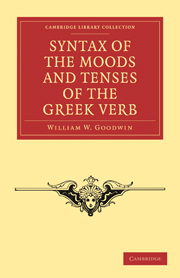The Cambridge Grammar of Classical Greek
This is the first full-scale reference grammar of Classical Greek in English in a century. The first work of its kind to reflect significant advances in linguistics made in recent decades, it provides students, teachers and academics with a comprehensive yet user-friendly treatment. The chapters on phonology and morphology make full use of insights from comparative and historical linguistics to elucidate complex systems of roots, stems and endings. The syntax offers linguistically up-to-date descriptions of such topics as case usage, tense and aspect, voice, subordinate clauses, infinitives and participles. An innovative section on textual coherence treats particles and word order and discusses several sample passages in detail, demonstrating new ways of approaching Greek texts. Throughout the book numerous original examples are provided, all with translations and often with clarifying notes. Clearly laid-out tables, helpful cross-references and full indexes make this essential resource accessible to users of all levels.
- The first comprehensive grammar of Classical Greek in English for a century, combining traditional grammatical description with the latest insights from general and Greek linguistics presented in a theoretically neutral fashion
- Contains a wealth of original examples taken from all genres of Classical Greek literature in order to help the reader understand actual usage in ancient texts
- Includes a section on textual coherence, without parallel in other grammars, which discusses particles and word order and uses a close analysis of four sample passages in order to illustrate the ways in which these and other features work together
Product details
March 2019Paperback
9780521127295
852 pages
246 × 173 × 37 mm
1.6kg
5 b/w illus. 130 tables
Available
Table of Contents
- Preface
- Abbreviations, symbols, editions
- On terminology
- Part I. Phonology and Morphology:
- 1. The signs and sounds of Classical Greek
- 2. Introduction to nominal forms
- 3. The article
- 4. Nouns
- 5. Adjectives and participles
- 6. Adverbs
- 7. Pronouns
- 8. Correlative pronouns and adverbs
- 9. Numerals
- 10. The dual: nominal forms
- 11. Introduction to verb forms
- 12. The present
- 13. The aorist: active and middle
- 14. The aorist: passive
- 15. The future: active and middle
- 16. The future: passive
- 17. The perfect (and future perfect): introduction
- 18. The perfect: active
- 19. The perfect: middle-passive
- 20. The future perfect
- 21. The dual: verb forms
- 22. Principal parts
- 23. Word formation
- 24. Accentuation
- 25. Ionic and other dialects
- Part II. Syntax:
- 26. Introduction to simple sentences
- 27. Agreement
- 28. The article
- 29. Pronouns and quantifiers
- 30. Cases
- 31. Prepositions
- 32. Comparison
- 33. The verb: tense and aspect
- 34. The verb: mood
- 35. The verb: voice
- 36. Impersonal constructions
- 37. Verbal adjectives
- 38. Questions, directives, wishes, exclamations
- 39. Introduction to complex sentences
- 40. Introduction to finite subordinate clauses
- 41. Indirect statements
- 42. Indirect questions and indirect exclamations
- 43. Fear clauses
- 44. Effort clauses
- 45. Purpose clauses
- 46. Result clauses
- 47. Temporal clauses
- 48. Causal clauses
- 49. Conditional clauses
- 50. Relative clauses
- 51. The infinitive
- 52. The participle
- 53. Overview of subordinate constructions
- 54. Overview of moods
- 55. Overview of the uses of ἄν
- 56. Overview of negatives
- 57. Overview of the uses of ὡς
- Part III. Textual Coherence:
- 58. Introduction
- 59. Particles
- 60. Word order
- 61. Four sample passages
- Bibliography
- Indexes.




